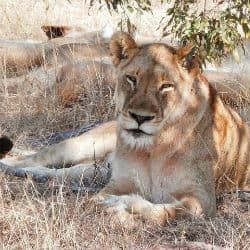News
We bring you the latest from around the World in wildlife and conservation news.
Lioness Seen Adopting Leopard Cub
Recently a wild lioness was seen suckling a leopard cub in a Tanzanian wildlife sanctuary. This is the first time such animal behaviour has ever been observed. Whilst certain big cats such as lions have been seen adopting and nursing other cubs of their own species, usually the kin of their relatives, seeing a cross species adoption is without precedent. Luke Hunter who is an expert on lions says he has never seen anything like it. The photos were taken earlier in the month by tourists with the leopard cub estimated to be roughly 3 weeks old.
Extremely Rare Pale Tiger Photographed In India
An extremely rare “pale tiger” that conservationists claim could have the fairest fur of any tiger in the wild has been photographed in Southern India. Belinda Wright, the founder of the Wildlife Protection Society of India says that the photographs show the palest tiger she has ever seen or heard about in literature. The tiger was captured on photograph earlier this month by wildlife photographer Nilanjan Ray whilst he was driving through a wildlife reserve in the Indian state of Tamil Nadu.
Polar Bears At Risk Of Chemical Toxin Contamination
Polar bears are already finding it difficult to deal with climate change. To add insult to injury, these giant Arctic carnivores also face the risk of being chemically poisoned, with levels in region about 100 times above what is considered safe for an adult bear according to the results of a new study. For bear cubs feeding on contaminated milk, the risk is ten times greater than for adults. This means the risk is a 1,000-fold for the baby bears.
Mountain Lions Afraid Of Human Beings
As human beings, it’s natural to be afraid of predators such as mountain lions, however what we fail to understand is that they may be more afraid of us than we are of them. This shouldn’t come as a surprise because humans have hunted the mountain lion from most of the continental United States. In fact, according to studies, fatal attacks by puma’s on human are relatively rare. The puma which is also known as panther, cougar, or mountain lion often flee large deer prey that they have hunted once they have heard the sound of humans. In the latest study, scientists were able to show that puma’s response to the human voice was immediate and lasting.
Poachers Hunting Elephants In Myanmar For Their Skin
The World Wildlife Fund says excessive demand for elephant skins means the survival of the species in Myanmar is at risk. Poachers in the South-East Asian country have migrated towards slaughtering the animals for their skins as the crack down on the ivory trade from wildlife conservationists has resulted in it becoming less profitable. There are approximately between 1,400 to 2,000 wild elephants in Myanmar according to Coconuts Yangon.
Campaigners Urge Mexico To Extend Ban On Gillnets To Save Rare Porpoise From Extinction
The world’s most endangered marine species, is desperate need of an immediate extension of a fishing ban if it is to be saved. According to campaigners, there are less than 30 vaquita porpoises left, with their population having plunged by as much as 90% since 2011. The porpoises are often accidental victims of gillnets which has resulted in a ban on their usage for two years back in 2015. Campaigners are pinning their hopes on the fact that the Mexican government will extend the ban which expired at the end of May.
Captured Burmese Python Found To Have Three Deer In Its Gut
A Burmese python was found in the Florida Everglades with three whole deer in its gut. The animals included one doe and two fawns. Wildlife officials in the area captured the snake and euthanised it according to a new study. The feat is a new world record as being the first invasive Burmese python captured with three deer in its gut said Scott Boback co-lead author of the study.
South African Government Has Plans To Legalise Trade In Rhino Horns
The South African Government is pushing ahead with plans to legalise the sale of the rhino horn within its borders. The proposed legislation will include a provision for the export of the animal product that is the reason behind a poaching crisis which many experts believe could result in the extinction of the species with ten years. Edna Molewa, South Africa’s Minister of Environmental Affairs filed draft regulations in February which would allow the sale of rhino horn in the country for “personal purposes” with a valid permit.







